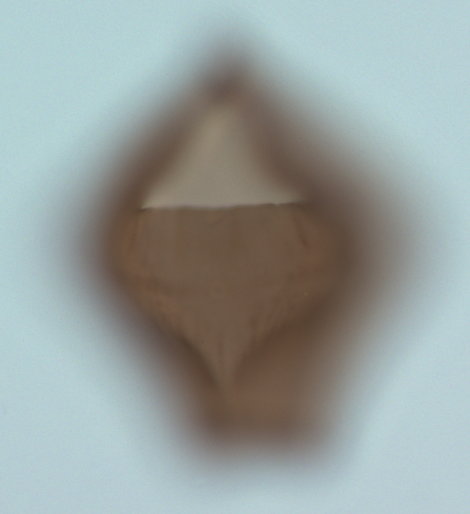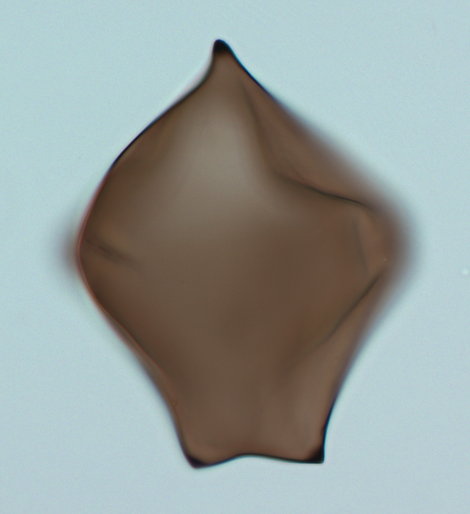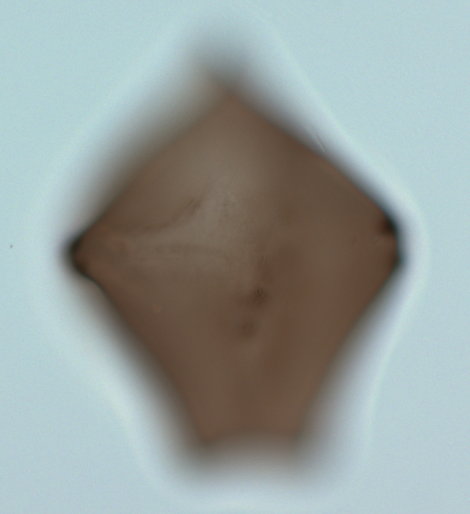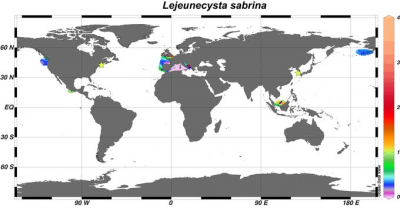Die Inhalte dieser Seite sind leider nicht auf Deutsch verfügbar.
Seitenpfad:
- Modern Dinocyst Key
- brown cysts
- cysts with peridinioid form
- Cysts without spines/processes
- Lejeunecysta sabrina
Lejeunecysta sabrina
Zonneveld, K.A.F. and Pospelova V. (2015). A determination key for modern dinoflagellate cysts. Palynology 39 (3), 387- 409.

dorsal view
photograph Karin Zonneveld
photograph Karin Zonneveld

cross section

ventral view
Field characteristics
Lejeunecysta sabrina (Reid 1977) Bujak 1984
Field characteristics:
Cyst pentagonal in dorso-ventral view with a deep ventral sulcus and two antapical horns separated by a deep or shallow antapical depression. Girdle equatorial, excavated, inclined and slightly displaced or circular; defined by sutures and/or parallel thickenings of the wall. Wall thin, thickening in the tips of the antapical horns, the girdle outline and in the sulcal flagellar scars. Surface microgranular. Archeopyle intercalary.
Motile affinity: Possibly Protoperidinium leonis (Pavillard 1916) Balech 1974.
Cyst-theca relationship: Dale, 1983
Stratigraphic range: Upper Pleistocene-Recent.
Comparison with other species:
This species differs from L. oliva by not having a pronounced cingulum. The cingulum is not depressed. No spines, ridges or striae are present on the cyst wall.
Field characteristics:
Cyst pentagonal in dorso-ventral view with a deep ventral sulcus and two antapical horns separated by a deep or shallow antapical depression. Girdle equatorial, excavated, inclined and slightly displaced or circular; defined by sutures and/or parallel thickenings of the wall. Wall thin, thickening in the tips of the antapical horns, the girdle outline and in the sulcal flagellar scars. Surface microgranular. Archeopyle intercalary.
Motile affinity: Possibly Protoperidinium leonis (Pavillard 1916) Balech 1974.
Cyst-theca relationship: Dale, 1983
Stratigraphic range: Upper Pleistocene-Recent.
Comparison with other species:
This species differs from L. oliva by not having a pronounced cingulum. The cingulum is not depressed. No spines, ridges or striae are present on the cyst wall.
Geographic distribution
Geographic distribution based on :
Zonneveld et al., 2013. Atlas of modern dinoflagellate cyst distribution based on 2405 datapoints. Review of Palaeobotany and Palynology, v. 191, 1-197
Zonneveld et al., 2013. Atlas of modern dinoflagellate cyst distribution based on 2405 datapoints. Review of Palaeobotany and Palynology, v. 191, 1-197
Lejeunecysta sabrina can be observed in temperate to tropical coastal regions of the western North Atlantic Ocean, the western Mediterranean Sea and adjacent basins, the South China Sea and the Bering Sea.

Distribution:
Lejeunecysta sabrina is sporadically observed in sediments of coastal areas from the temperate to tropical northern Hemisphere regions of the western North Atlantic Ocean, the western Mediterranean Sea, the Adriatic Sea, the South China Sea and the Bering Sea. Highest abundances up to 3% occur in the Irish Sea and in the South Adriatic Sea.
Environmental parameter range:
SST: 8.0°C - 29.7°C (winter - summer) and summer SST > 14°C. Exception is formed by three samples where SST is as low as 1.7°C in winter and 8.2°C in summer. SSS: 29.7 - 38.9 (spring - summer), [P]: 0.1 - 1.7 μmol/l, [N]: 0.04 - 14.6 μmol/l, chlorophyll-a: 0.11 - 2.7 ml/l, bottom water [O2]: 0 - 6.8 ml/l. This species has its highest abundances in sites where anoxic bottom waters prevail.
Comparison with other records:
Apart from the observations included into this Atlas L. sabrina has been observed in New england estuaries (Pospelova et al., 2004, 2005) and coastal bays of southern Korea that are characterized by high nutrient concentrations and an unstratified water column (Pospelova and Kim, 2010).
Lejeunecysta sabrina is sporadically observed in sediments of coastal areas from the temperate to tropical northern Hemisphere regions of the western North Atlantic Ocean, the western Mediterranean Sea, the Adriatic Sea, the South China Sea and the Bering Sea. Highest abundances up to 3% occur in the Irish Sea and in the South Adriatic Sea.
Environmental parameter range:
SST: 8.0°C - 29.7°C (winter - summer) and summer SST > 14°C. Exception is formed by three samples where SST is as low as 1.7°C in winter and 8.2°C in summer. SSS: 29.7 - 38.9 (spring - summer), [P]: 0.1 - 1.7 μmol/l, [N]: 0.04 - 14.6 μmol/l, chlorophyll-a: 0.11 - 2.7 ml/l, bottom water [O2]: 0 - 6.8 ml/l. This species has its highest abundances in sites where anoxic bottom waters prevail.
Comparison with other records:
Apart from the observations included into this Atlas L. sabrina has been observed in New england estuaries (Pospelova et al., 2004, 2005) and coastal bays of southern Korea that are characterized by high nutrient concentrations and an unstratified water column (Pospelova and Kim, 2010).


